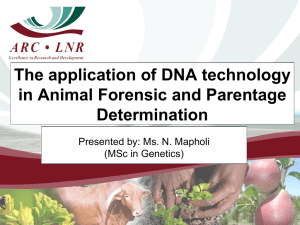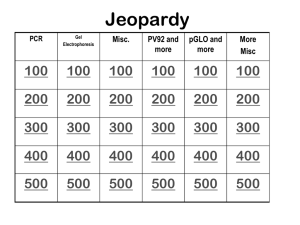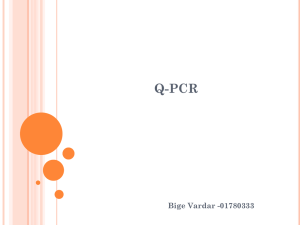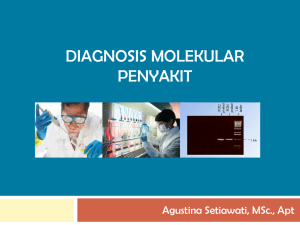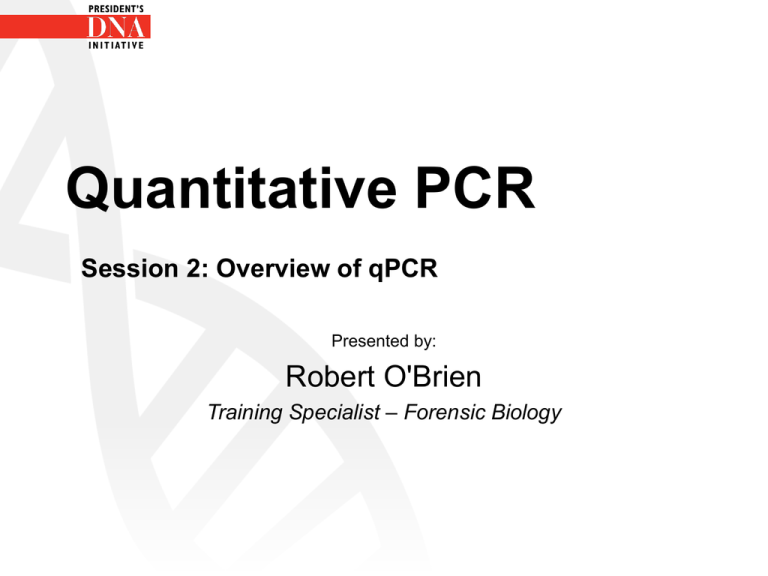
Quantitative PCR
Session 2: Overview of qPCR
Presented by:
Robert O'Brien
Training Specialist – Forensic Biology
Quantitative PCR
Session 2- Overview of qPCR
Differences between PCR and qPCR
Why Real- Time PCR
PCR Mechanism
Phases of qPCR amplification
qPCR chemistry
qPCR process
Relationship between the CT value and the
quantity of DNA
Differences between PCR and
qPCR
PCR (end point PCR)
• Products are analyzed after the cycling is
completed (static) using gels, CE, UV or
fluorescence detection
• End point assay means results are viewed at
end, the end result is all that is important
Differences between PCR and
qPCR
• qPCR products are monitored as the PCR is
occurring (dynamic)
• Monitoring is occurring once per cycle
• Fluorescence is measured
• Kinetics of the system- what is happening during
the entire process is what is important, not the
end product
Why Real-Time PCR
(Advantages and Disadvantages)
– Advantages
• Availability of commercial qPCR kits and
instrumentation
• Higher throughput and less user
intervention
• Simple data analysis
• Software rapidly analyzes data
Why Real-Time PCR
• Advantages
• Process sensitive to same inhibitors as end point
amplification due to presence of an internal
control
• No post PCR manipulation
• High sensitivity
• Large range of quantities that can be detected
• Assays can be made to target different types of
DNA and in some cases can be multiplexed
Why Real-Time PCR
• Disadvantages of qPCR
• At very low or high levels of DNA precision may
suffer.
• Can give the incorrect quantity if DNA sample is
degraded
• qPCR assumes the sample is quantified at same
efficiency as the calibrant sample
• Results are calculated based on the calibrants. If
the calibrants are made up wrong then the
quantities of the samples will be wrong.
PCR Mechanism
• PCR- Polymerase Chain Reaction
• Result of the PCR reaction is an exponential
increase in PCR products
• The amount of DNA present theoretically doubles
with every cycle
PCR Mechanism
• Starting with one copy of
DNA
• Doubling after one cycle
to give 2 copies
• After two cycles another
doubling to produce 4
copies and so on
Cycle
0
1
2
3
4
5
6
7
8
9
10
11
12
13
14
15
16
17
18
19
20
Copies
1
2
4
8
16
32
64
128
256
512
1024
2048
4096
8192
16384
32768
65536
131072
262144
524288
1048576
PCR Mechanism
PCR Mechanism
Phases of qPCR amplification
• There are 4 Phases that occur during the PCR
process.
•
•
•
•
1st Phase- Lag phase
2nd Phase- Exponential phase
3rd Phase- Linear phase
4th Phase- Plateau phase
Phases of qPCR amplification
4 phases of qPCR amplification
Lag Phase, Exponential Phase, Linear Phase and Plateau Phase
Phases of qPCR amplification
Lag Phase
• This is the first phase in
PCR process
• During this phase there is
an increase in PCR
product but fluorescence
produced by this increase
is too low to be detected
• During lag phase the
baseline is being set
Phases of qPCR amplification
Exponential phase
• Also known as the geometric phase
• During the exponential phase PCR efficiency is
at 100%
• There is an abundance of all reaction
components - polymerase, free dNTPS,
template DNA, primers etc.
• As PCR product continues to increase the ratio
of Ampli Taq Gold DNA polymerase to PCR
product decreases
Phases of qPCR amplification
• Exponential phase
– The signal is in direct
proportion to the
increase of PCR
product
– A plot of DNA
concentration vs cycle
number on a log scale
should approximate a
straight line
Phases of qPCR amplification
Linear phase
– One or more components of PCR have
decreased below a critical concentration
therefore amplification begins to decrease
– Phase is called linear because amplification
approximates an arithmetic progression rather
than a geometric increase
– Amplification efficiency is continually
decreasing during linear phase
Phases of qPCR amplification
Linear Phase
Slope of amplification plot decreases significantly
Phases of qPCR amplification
Plateau Phase
• PCR reaction has stopped
• There is no increase in PCR product therefore no more
fluorescence
• Amplification plot is a straight flat line
qPCR Chemistry
• Overview
– Two 5’ nuclease assays
– One for target of Total Human DNA or Human
male DNA
– One for target of Internal PCR Control (IPC)
qPCR Chemistry
• Components of Target Specific Assay
• Two primers for amplifying total human DNA or
male human DNA
• One Taqman ® MGB probe labeled with FAM
dye for detecting the amplified sequence
qPCR Chemistry
•
•
•
•
•
Targets of PCR
Total Human
Human Telomerase reverse transcriptase gene
(hTERT gene)
Location 5p15.33
Amplicon length- 62 bases
Non translated region is amplified
Diploid
qPCR Chemistry
•
•
•
•
•
Targets of PCR
Human male
Sex determining region Y gene (SRY)
Location Yp11.3
Amplicon length 64 bases
Non-translated region is amplified
Haploid
qPCR Chemistry
• IPC assay components
• IPC template- DNA is synthetic not found in
nature
• Two primers for amplifying the IPC template
DNA
• One Taqman ® MGB probe labeled with VIC dye
for detecting amplified DNA
qPCR Chemistry
Taqman ® MGB Probe
Made up of a reporter dye
FAM dye or VIC dye linked to the 5’end of the
probe
Has a Minor groove binder (MGB) at the 3’
end of the probe
Non-fluorescent quencher (NFQ) at the 3’ end
of the probe
qPCR Chemistry
• Taqman ® MGB Probe
• Importance of MGB at 3’end of probe
– Increases melting temperature of probe
without increasing length
• Melting temperature needs to be high so
probe is not destroyed during heating
cycles of PCR
• If probe is too long quencher dye and
reporter dye will be too far so signal from
reporter dye will not be suppressed
qPCR Chemistry
Taqman ® MGB probe
• The proximity of the reporter dye to the quencher
dye allows for suppression of the fluorescence
from the reporter dye by a Förster type energy
transfer.
qPCR process
• 5’ nuclease assay process (Nuclease activity is
on the 5’ end of the probe)
– 1- Occurs during PCR amplification
– 2- Occurs in every cycle
– 3- Does not interfere with exponential
accumulation of product
qPCR process
Components of qPCR
qPCR process
• Step 1- Taqman ® MGB Probe anneals specifically to a
complementary sequence between the forward and
reverse primer sites
qPCR process
• Step 2 - qPCR process begins
• Ampli Taq Gold DNA ploymerase begins its polymerase
activity incorporating free dNTPS
• Ampli Taq Gold DNA polymerase has a 5’ nuclease
activity
qPCR process
As Ampli Taq Gold DNA polymerase progresses on the
strand of DNA it cleaves off the reporter dye on the 5’ end of
probe.
As the reporter dye is cleaved it is no longer close enough
to the quencher dye for suppression of fluorescence to
occur.
As a result fluorescence from reporter dye can be detected
qPCR process
qPCR process
As the Ampli Taq Gold DNA polymerase progresses it will
displace the probe
qPCR process
• IPC
• IPC undergoes same process as template DNA
• Because it is a synthetic sequence and labeled
with a VIC dye its fluorescence is detected
separately
Relationship between the CT value
and the Quantity of DNA
• CT value is the cycle at which the fluorescence
reaches a high enough level to cross the
threshold.
• A low CT value means it took less cycles for the
fluorescence to cross the threshold
• If every cycle is a doubling of product then the
product did not have to be doubled many times
to reach a certain level
Relationship between the CT value
and the Quantity of DNA
• Therefore the input of DNA would be more if the
CT was low.
• Therefore the more DNA present the lower the
CT value.
• Thus the CT value and quantity of DNA are
inversely proportional to each other
• The software is able to calculate the input
amount of DNA based on the CT value of the
sample.
Relationship between the CT value
and the Quantity of DNA
• To obtain the quantity of DNA from the CT value a
curve is created using known concentrations of
DNA vs their CT values
• From this curve the quantity of DNA from
unknown samples can be calculated based on
their CT value
• The calculation is based on a doubling of PCR
product.
Relationship between the CT value
and the Quantity of DNA
• Therefore the portion of the amplification plot
looked at is when the PCR reaction is occurring
at 100% efficiency
• This occurs during the exponential phase
• The standard curve is a graph of the CT of the
standards vs the Log of the Concentration of the
standards
Relationship between the CT value
and the Quantity of DNA
• The quantifiler software calculates the
regression line by calculating the best fit curve
with the quantification standard data points
•
•
•
•
•
Regression line formula
CT = m (log Qty) + b
Fits formula for a straight line
Y= mx +b
Y= CT, m=slope, x = log qty, b= y intercept
Relationship between the CT value
and the Quantity of DNA
•
•
•
•
Calculating Quantity
CT= m (log Qty) + b
CT -b = m (log Qty)
(CT -b)/m =log qty
•
10 [ (C
T
–b)/m]
= Qty
Relationship between the CT value
and the Quantity of DNA
• Qty= starting quantity of DNA
• R² value- Measure of the closeness of the fit between the
standard curve regression line and the individual Ct data
points of the standards. A value of 1.00 means a perfect
fit. R² value > 0.99 represents a close fit.
• Slope indicates the PCR amplification efficiency for the
assay.
• A slope of -3.3 indicates 100% amplification efficiency.
• The Standard curve shows all this information and it is
used to assess if the standards for the plate were set up
correctly.
Relationship between the CT value and the
Quantity of DNA
Quantitative PCR
•
•
•
•
•
•
•
•
Reaction efficiency = [10 (-1/m) ]-1
Reaction efficiency of 100% = 1
1= [10 (-1/m) ]-1
Solving for m (slope)
2 = 10 (-1/m)
Log 2 = -1/m
-1/log 2 = m
-3.3= m
• Y intercept indicates expected CT value for a
sample with qty = 1ng/µl





